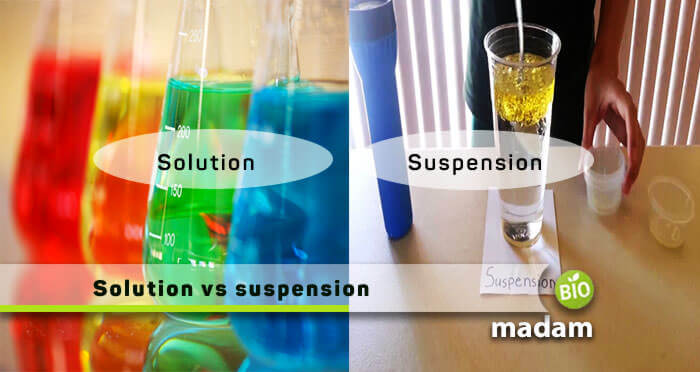We come across numerous physical and chemical reactions every day that come under Chemistry. A sub-discipline of chemistry subsequently deals with multiple reactions between mixed substances, where some are solutions, suspensions, and colloids. We can prepare both when one substance mixes with another one of a similar or distinct type. Today, we will go through the primary differences between solution and suspension, so continue reading the article below.
Despite many differences, the one that holds the prime position in differentiating the two mixtures is the particle size. Solutions consist of comparatively smaller solute particles than the suspensions. However, we can still manage to segregate the individual components of both systems by physical means.
Let’s start with briefing a comparison table between solution and suspension.
Comparison Chart
| Parameters | Solution | Suspension |
|---|---|---|
| Visibility | Light microscope needed | Seen with the naked eye |
| Particle Size | Less than one nanometer | More than a thousand nanometers |
| Nature of Settling Down | Never settles | Solute particles settle down |
| Filterability | Passes through filters | Do not pass |
| Nature of Dispersion | Uniform | Non-uniform |
| Mixture Properties | Transparent | Cloudy |
| Tyndall Effect | Absent | Present |
| Diffusion Property | Easily diffuses | Never diffuses |
What is a Solution?
A solution is the homogeneous mixture of two or more components with properties evenly distributed. A true solution is the combination of two substances, solute, and solvent. A solute is a substance dissolved in a solvent and changes its state while forming a solution. The particles of a solution can be seen under an electron microscope instead of compound microscope.
It is present in excess concentration. In contrast, a Solvent is a substance that can dissolve other substances (solute). Both solute and solvent are in the same phase of matter, making the solution cloudy. Besides, a solution can let the light pass through it without getting scattered; thus, the Tyndall effect (scattering of light) is absent in the solution.
The solution can pass through easily from ordinary filter paper and also through the animal membrane, and no residue is left on the filter paper, but solute and solvent can’t be separated with ordinary filter or ultra-filtration. There is no Brownian effect, or Brownian motion (random, uncontrolled movement of particles in the fluid) is not observed in the solution. An example of a solution is saltwater, sugar dissolved in water.
Types of Solution
Solutions are classified into several subtypes, depending on their physical state, number of solutes, or nature of a solution. Let’s discuss all of them below:
Types Based on Physical State
Solid Solution: As the name indicates, a solid solution contains the solute and the solvent in the solid-state. Some examples are steel (composed of carbon and iron), brass (composed of zinc and copper), and sterling silver
Liquid Solution: This type of solution contains solvent in the liquid form, for example, alcohol in water, saltwater, etc.
Gaseous Solution: A homogeneous mixture of gases, e.g., hydrogen (solute) dissolved in palladium (solvent), is a type of gaseous solution.
Types Based on Number of Solutes
Dilute Solution: This type of solution has a diluted/small amount of solute in a large solvent concentration.
Concentrated Solution: When a solution is prepared with a large amount of solute dissolved in a small amount of solvent, it becomes a concentrated solution.
Types Based on Nature of Solution
Supersaturated Solution: A supersaturated solution is one where the solute is present in an excess amount and more than the average solvent can be dissolved at a given temperature.
Unsaturated Solution: A solution that contains less amount of solute is unsaturated. In other words, when the solute concentration is lower than its equilibrium solubility, it forms an unsaturated solution.
Saturated Solution: A solution in which no more solute can dissolve the solvent at a definite temperature refers to a saturated solution.
Aqueous Solution: The solution that contains water as the solvent is called an aqueous solution. It can be a solution with any solute kind, but the solvent should always be water, for example, sugar in water.
Non-Aqueous Solution: The solution that should never involve water as a solvent refers to the non-aqueous solution. Some common examples of non-aqueous solutions are liquid ammonia, liquid sulfur dioxide, etc.
What is a Suspension?
A suspension is a heterogeneous mixture of two or more substances where the solid particles (size greater than 1000 nm) are spread throughout the liquid without dissolving. Furthermore, we can observe the solute particles in a suspension with our naked eyes. Suspension cannot be filtered with filter paper because of not tend to pass through filters. Therefore, if you filter a suspension, the insoluble particles will be collected as residue on the paper. They are opaque and can’t pass light through them. Still, if light manages to pass through suspension, the particles inside scatter the light rays due to their larger size. Hence, suspension shows the Tyndall effect. You can observe the particles under a student microscope.
Suspensions are unstable, so there is no particular phase to them. The particles automatically tend to separate if they’re allowed to stand for some time. It can be in a solid-liquid phase, liquid-liquid phase, and a solid-gas phase, for example:
- Muddy Water
- Milk of Magnesia
- CaCO3 in Water
- Soot in Air
- Mercury in Oil
- Flour in Water, etc.
Differences between Solution & Suspension
There’s a complete list of differences between the two systems described below.
Size of Particles
Solution
The particle sizes should be less than one nanometer, so it’s impossible to observe them with the naked eye. Therefore, technicians utilize different physical means to separate solute from a solution.
Suspension
On the contrary, the particles are comparatively larger than the solution, also visible from the naked eye. The size starts from above 1000 nanometers.
Nature of Composition
Solution
These systems are homogenous, which means the solute and solvent have uniformity in them. In other words, they are evenly distributed in the entire system.
Suspension
In contrast, suspensions are heterogeneous systems representing the non-uniformity of solute and solvent.
Appearance/Color
Solution
All solutions are transparent after getting fully prepared. Hence, it’s easy for light to travel through them. Moreover, the small size of the particles does not scatter the light rays, thus, neglecting the Tyndall effect.
Suspension
On the other hand, suspensions have a cloudy appearance where the particles involved scatter light touching them. Therefore, suspensions display the Tyndall effect.
Phase Consistency
Solution
All the solute particles and solvents remain in one phase in a solution, so maintaining consistency.
Suspension
On the contrary, we see different phases for a suspension, such as solid-liquid and solid-gas phases.
Diffusion Property
Solution
A solution can undergo different diffusion processes to easily diffuse due to its acquiring uniform nature.
Suspension
On the contrary, a suspension never diffuses because of having large solute particles.
Examples
Solution
There’s a long list of examples of solutions, such as saltwater, alcohol in water, sublimation of iodine in air, etc.
Suspension
Similarly, suspension mixture also has numerous examples from our daily life, including milk of magnesia, slaked lime for whitewashing, dyes suspended in paint, etc.
Conclusion
The nature of solution and suspension will still remain as a mixture besides being quite different from each other. We can separate both solution mixtures and suspension mixtures, through physical methods, for example, distillation.

Hello, I would like to introduce myself to you! I am Chelsea Rogers, an experienced blog writer for science articles, holding an MPhil degree. My enthusiasm to grab the best knowledge, let it relate to botany, zoology, or any other science branch. Read my articles & let me wait for your words s in the comment section.

